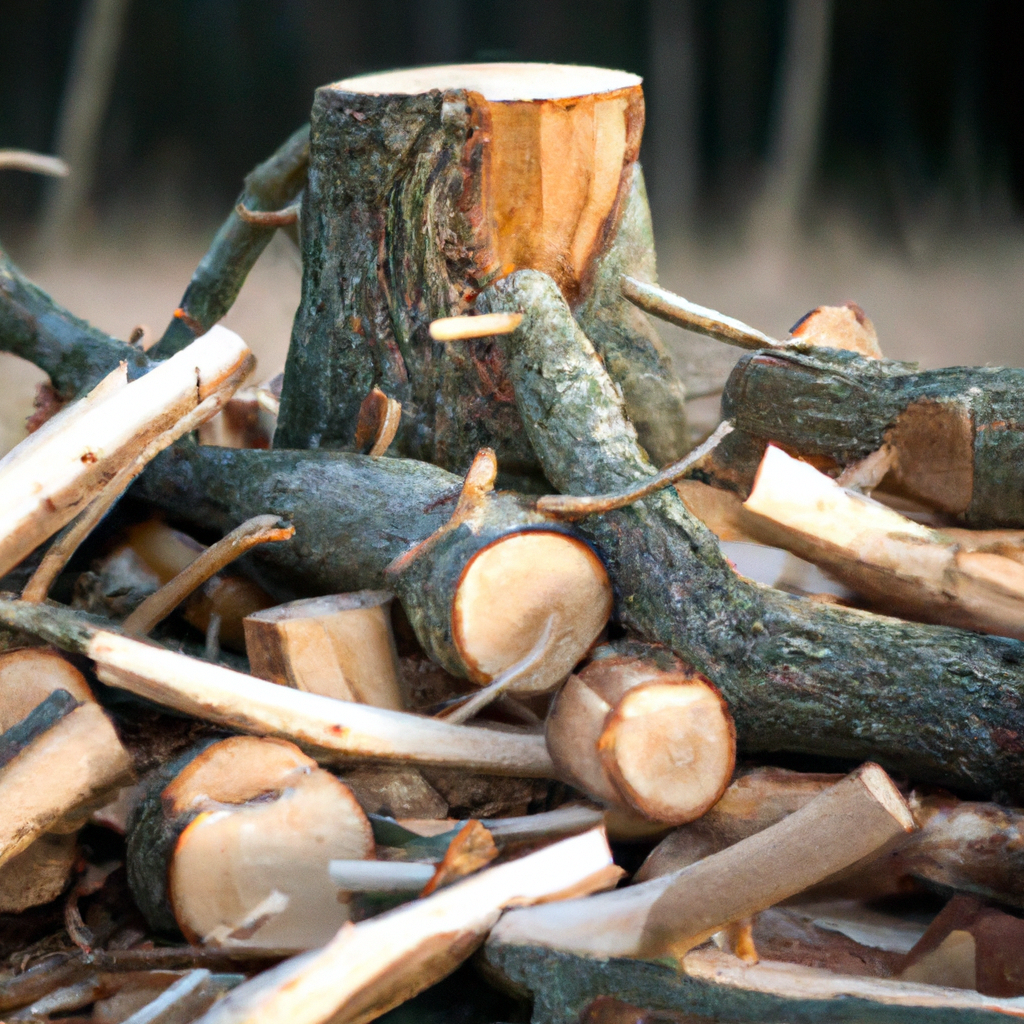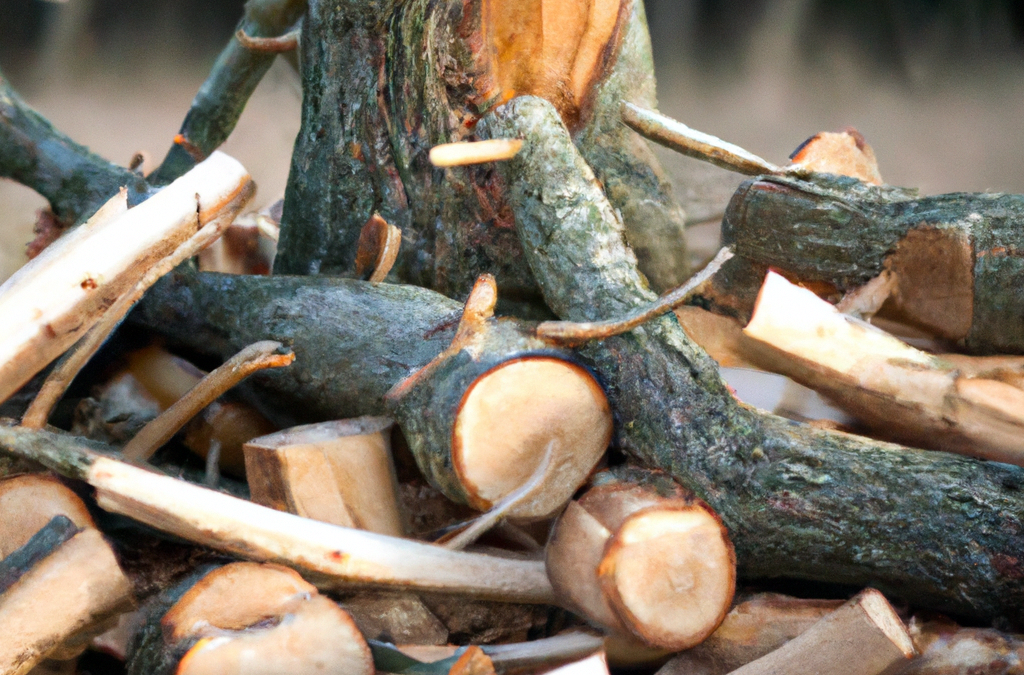Imagine you have a towering tree in your backyard that needs to be removed as soon as possible. But you’re faced with a daunting task – how do you cut down a tree quickly? In this article, we will explore the most efficient techniques and tools to help you tackle this challenge with ease. Whether you’re an experienced lumberjack or a novice in the world of tree removal, we’ve got you covered. So let’s roll up our sleeves and find out how you can get that tree down in no time!

Choosing the Right Equipment
Selecting the Ideal Chainsaw
When it comes to cutting down a tree quickly and efficiently, having the right equipment is essential. One of the most important tools you’ll need is a chainsaw. When selecting a chainsaw, it’s important to consider factors such as the size of the tree you’ll be cutting down and your own level of experience. For smaller trees or branches, a smaller chainsaw with a shorter blade may suffice. However, for larger trees, you’ll want a more powerful chainsaw with a longer blade.
Gathering Safety Gear
Before you start cutting down a tree, it’s crucial to prioritize safety. This means gathering the proper safety gear to protect yourself from potential hazards. Safety gear for tree removal typically includes items such as a hard hat, safety goggles, ear protection, gloves, and steel-toed boots. These items will help protect you from falling debris, flying wood chips, loud noise, and any potential accidents during the tree removal process.
Inspecting and Preparing Equipment
Once you’ve selected the appropriate chainsaw and gathered your safety gear, it’s important to inspect and prepare your equipment before beginning any tree removal work. Check the chainsaw for any signs of damage or wear, ensuring that it is in proper working condition. Additionally, make sure to sharpen the chainsaw blade and fill the fuel tank with the appropriate fuel mixture. Properly preparing your equipment will help ensure its effectiveness and prevent any potential issues while cutting down the tree.
Preparing the Tree for Removal
Evaluating the Surroundings
Before you begin the tree removal process, take the time to thoroughly evaluate the surroundings of the tree. Look for any obstacles that may interfere with the safe removal of the tree, such as nearby buildings, power lines, or other trees. It’s important to have a clear understanding of the space you’ll be working in to minimize the risk of accidents and property damage.
Removing Obstacles
Once you’ve identified any potential obstacles, it’s important to remove them before starting to cut down the tree. This may involve trimming nearby branches or clearing away any debris that could hinder the tree’s fall. By removing these obstacles, you’ll create a safer working environment and reduce the chances of complications during the tree removal process.
Creating an Escape Route
Creating an escape route is a crucial step in ensuring your safety during tree removal. An escape route is a predetermined path that you can quickly and safely take if the tree falls in an unexpected direction. Clear any debris or obstructions along the escape route to ensure a quick and unobstructed exit. Planning and creating a clear escape route will provide you with peace of mind and help prevent any potential accidents.
Assessing the Tree
Identifying Potential Hazards
Before cutting down the tree, it’s important to identify any potential hazards that may affect the tree’s stability or pose a risk during the removal process. Look for signs of decay, cracks, or weak branches that could break off and cause injury. Additionally, assess the tree’s overall health and stability to determine if there are any underlying issues that may impact its fall.
Checking for Diseased or Damaged Areas
Inspect the tree for any diseased or damaged areas. These areas may be weakened and more prone to breaking or falling. If you notice any signs of disease or damage, take the necessary precautions to ensure your safety while cutting down the tree. It may be advisable to consult with a professional arborist if you are unsure about the health of the tree or its potential dangers.
Determining the Direction of Fall
Before making any cuts, take the time to determine the direction in which you want the tree to fall. This will depend on the surrounding space and any potential obstacles. Choosing the right direction for the tree to fall will help minimize damage to nearby structures and ensure a safer tree removal process overall.
Making the Initial Cuts
Making the Notch Cut
To initiate the tree cutting process, start by making a notch cut on the side of the tree in the direction you want it to fall. The notch cut should be a triangular-shaped cut, with the wider part facing the direction of the desired fall. This cut helps guide the tree’s fall and should be made about one-third of the way into the tree’s diameter.
Performing the Felling Cut
After making the notch cut, move to the opposite side of the tree and perform the felling cut. The felling cut should be horizontal and made slightly above the bottom of the notch cut. This cut will determine the thickness of the remaining wood that will hold the tree in place until it falls. It’s important to ensure that the felling cut is parallel to the notch cut, as this will help control the tree’s fall direction and prevent any unwanted twists or turns.

Safe and Efficient Cutting Techniques
Using Wedges to Guide the Fall
For larger trees or those that are at risk of falling in an undesirable direction, using wedges can help guide the fall. Wedges are inserted into the back cut and create a hinge that controls the tree’s direction of fall. By strategically placing wedges and adjusting their position, you can steer the tree towards your desired fall direction and increase safety during the cutting process.
Making Back Cut at the Correct Height
When making the back cut, it’s important to ensure that it is made at the correct height. The back cut should be slightly above the level of the notch cut, leaving enough supporting wood to maintain the tree’s stability until it falls. Making the back cut at the correct height will help prevent premature falling and provide a safer working environment.
Maintaining Proper Cutting Angle
Throughout the cutting process, it’s important to maintain a proper cutting angle to prevent the chainsaw from getting stuck in the wood. Avoid cutting at too steep of an angle, as this can increase the risk of kickback or the chainsaw getting stuck. Maintaining a proper cutting angle will not only make the process more efficient but also help ensure your safety while cutting down the tree.
Dealing with Potential Complications
Dealing with Leaning Trees
In some cases, you may encounter trees that are leaning in a specific direction. When faced with a leaning tree, it’s important to assess the direction of the lean and adjust your cutting techniques accordingly. Making strategic cuts to counterbalance the lean and effectively guide the tree’s fall will help prevent the tree from falling unpredictably or causing damage.
Handling Hollow or Brittle Trees
Hollow or brittle trees pose additional challenges during the removal process. It’s important to exercise caution when dealing with these types of trees, as they may be structurally unsound and prone to crumbling or breaking. In such cases, it may be advisable to seek professional assistance to safely cut down the tree and prevent any potential accidents.
Addressing Multiple Stems or Branches
Trees with multiple stems or branches require careful consideration and planning before removal. It’s important to identify the main stem or branch that will control the direction of the fall and make cuts accordingly. Taking the time to assess the tree’s structure and strategically plan the cutting process will help ensure a safe and efficient tree removal.

Ensuring Safety at All Times
Working with a Partner
When cutting down a tree, it’s recommended to work with a partner. Having a partner provides an extra set of eyes and hands, increasing safety during the cutting process. Your partner can assist with evaluating the tree, providing feedback on the fall direction, and ensuring that all safety protocols are followed.
Protective Measures for Eyes and Ears
Protecting your eyes and ears is crucial during tree removal. Wear safety goggles to shield your eyes from flying debris, and use ear protection to minimize the impact of loud noise from the chainsaw. By protecting your eyes and ears, you reduce the risk of injury and maintain your overall well-being throughout the process.
Avoiding Power Lines or Other Obstacles
Before cutting down a tree, always be aware of any power lines or other obstacles in the vicinity. Ensure that you maintain a safe distance from power lines to prevent potential electrocution. Additionally, take caution to avoid damaging nearby structures or property during the tree removal process. By being mindful of potential obstacles, you can ensure a safer and more efficient cutting experience.
Cleaning Up after Tree Removal
Removing Branches and Debris
Once the tree has fallen, it’s important to clean up any branches and debris left behind. Remove branches from the site and stack them for disposal or later use as firewood. Collect and dispose of any smaller debris or wood chips to ensure a clear working area and minimize the risk of tripping or other accidents.
Properly Handling and Storing Equipment
After completing the tree removal process, properly handle and store your equipment. Drain any remaining fuel from the chainsaw and clean it thoroughly to remove dirt and debris. Safely store the chainsaw and other equipment in a secure location to prevent any accidents or unauthorized use.
Implementing Tree Stump Removal Techniques
If you wish to completely remove the tree stump from your property, there are various techniques you can employ. These include using a stump grinder to mechanically grind the stump down to ground level or using chemical stump removers to accelerate the decomposition process. Each method has its own advantages and considerations, so it’s important to research and choose the most suitable option for your specific situation.

Environmentally Friendly Disposal Methods
Recycling the Wood
When removing a tree, you can opt to recycle the wood rather than disposing of it. Utilize the cut wood for firewood, crafting projects, or even as material for woodworking. Recycling the wood not only reduces waste but also allows you to make use of the tree in a sustainable manner.
Utilizing Tree Chips or Mulch
Another environmentally friendly disposal method is to utilize the tree chips or mulch produced during the tree removal process. These wood chips can be used as mulch for your garden or landscaping projects, providing benefits such as moisture retention and weed suppression. Utilizing tree chips or mulch is a sustainable way to repurpose the tree and contribute to a healthier ecosystem.
Hiring Professional Tree Removal Services
If you’re unsure about the tree removal process or lack the necessary skills and equipment, it may be wise to hire professional tree removal services. Professionals have the expertise and experience to safely and efficiently remove trees, ensuring compliance with local regulations and minimizing any potential risks. By hiring professionals, you can delegate the task to experts while maintaining peace of mind and avoiding unnecessary stress.
Ensuring Compliance with Local Regulations
Checking for Necessary Permits
Before removing a tree, it’s important to check if any permits or permissions are required by your local authorities. Municipalities may have regulations in place to protect trees and require permits for their removal. Avoid potential legal issues and fines by ensuring that you comply with all necessary regulations and obtain the appropriate permits before undertaking any tree removal work.
Understanding Noise or Time Restrictions
Some areas may have noise or time restrictions in place that could impact the tree removal process. These restrictions may limit the hours during which you can operate machinery or perform any noisy activities. It’s crucial to familiarize yourself with these restrictions and plan your tree removal accordingly to avoid any unnecessary conflicts or disturbances.
Complying with Tree Preservation Policies
Certain locations may have tree preservation policies in place to protect and maintain the natural environment. These policies may regulate the removal of certain tree species or dictate alternative measures such as tree preservation plans. Familiarize yourself with these policies and ensure you comply with any guidelines or requirements to protect the local ecosystem and maintain environmental sustainability.
In conclusion, cutting down a tree quickly and safely requires careful planning, the right equipment, and an understanding of proper cutting techniques. By following the outlined steps and prioritizing safety throughout the process, you can successfully remove a tree while minimizing risks and potential complications. Whether you decide to tackle the tree removal yourself or hire professionals, ensure compliance with local regulations and consider environmentally friendly disposal methods to promote sustainable practices. Remember, tree removal can be a complex task, so it’s always best to proceed with caution and seek professional guidance if you have any doubts or concerns.


